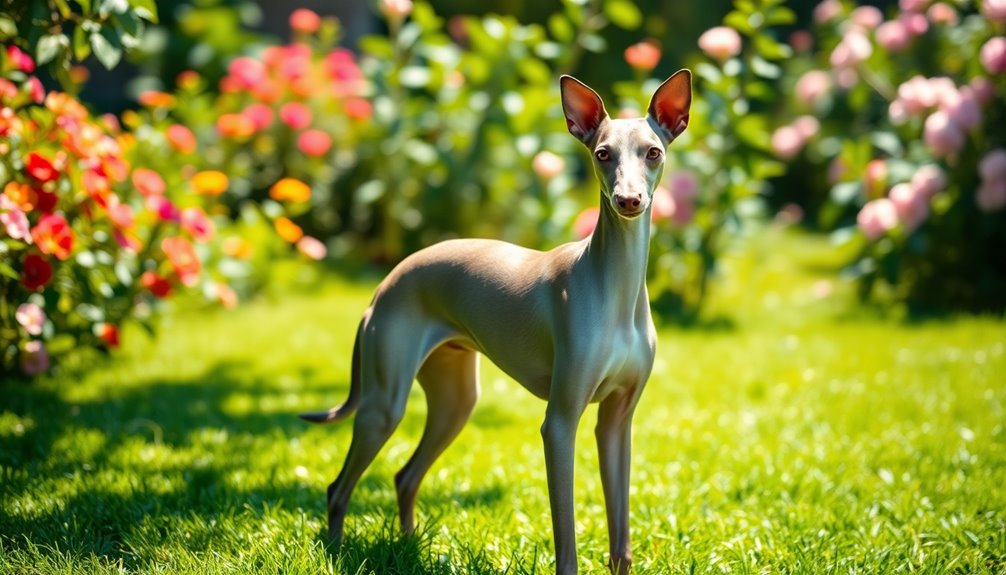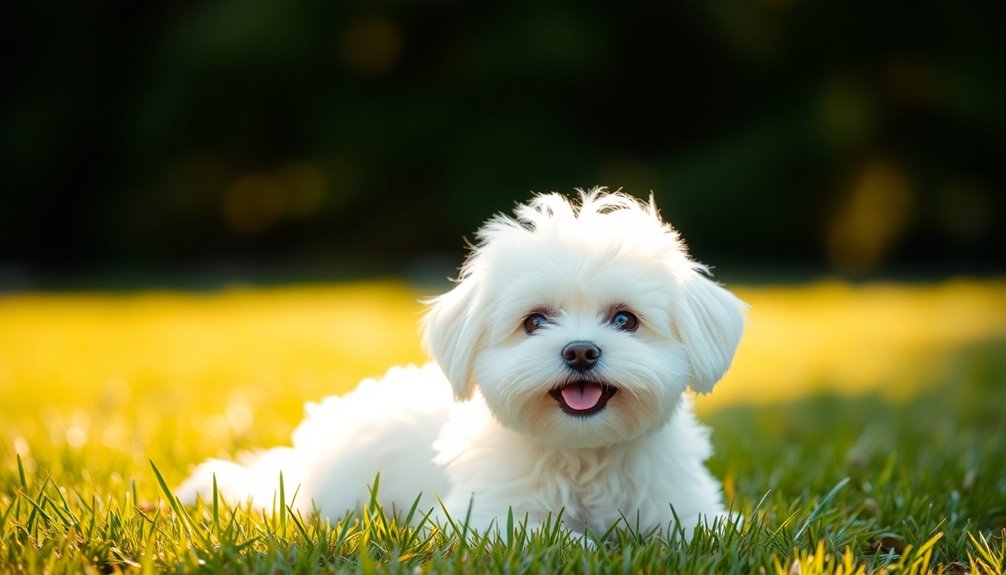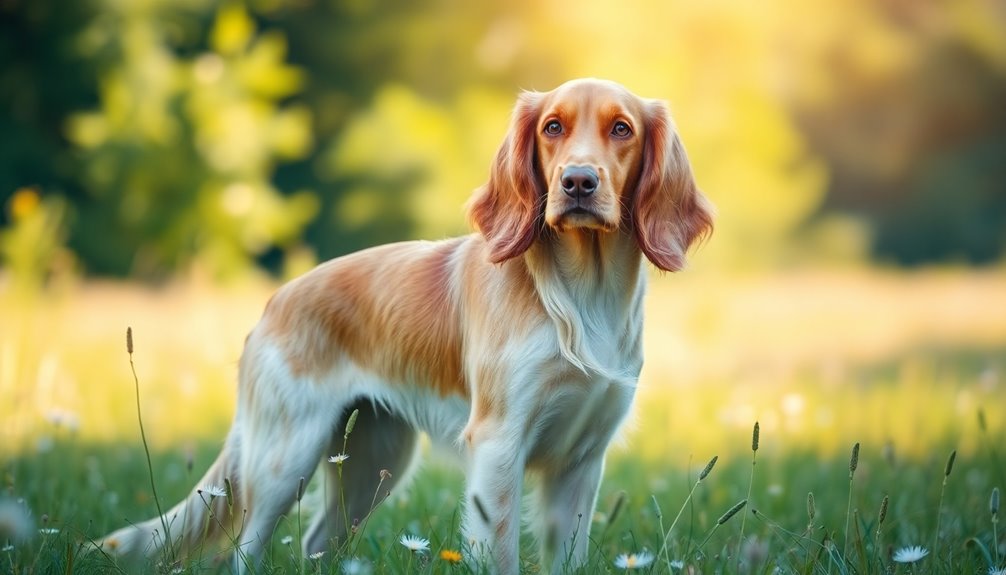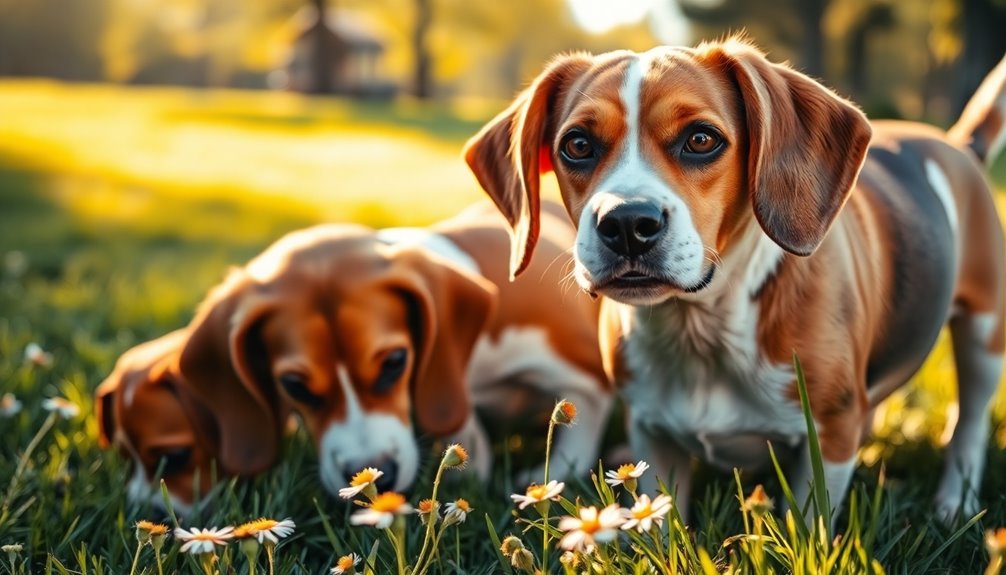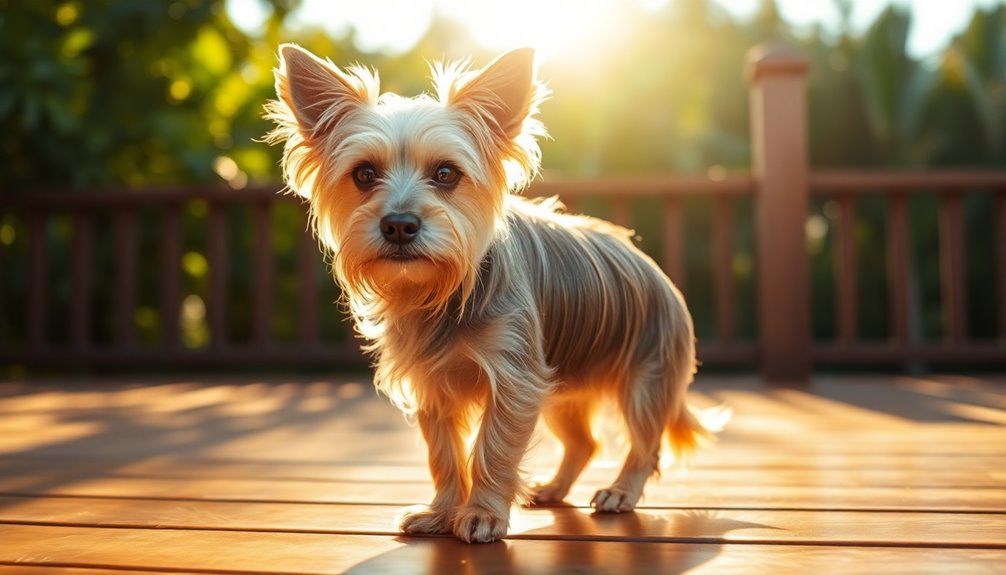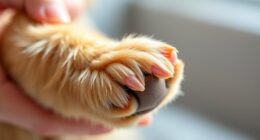The Irish Wolfhound, often called the "gentle giant," stands tall and proud, reaching heights of at least 30 inches. With their calm demeanor and affectionate nature, they're perfect companions for families. These dogs bond deeply with their humans and get along well with children, despite their large size. They need moderate exercise, usually around 20-40 minutes daily, and enjoy a mix of walks and playtime. Regular grooming keeps their wiry coat healthy and enhances your connection. If you're curious about their history, health, and training needs, there's much more to explore about these magnificent dogs.
Key Takeaways
- Irish Wolfhounds are known as the "gentle giant" due to their calm, patient demeanor and affectionate nature towards families and children.
- Originating in Ireland around 273 BC, they were bred for hunting and protection, symbolizing courage and loyalty.
- They typically weigh between 105-155 pounds and stand at least 30 inches tall, with a wiry coat requiring regular grooming.
- With an average lifespan of 6-8 years, they are prone to health issues like bloat and bone cancer, necessitating regular veterinary care.
- Irish Wolfhounds require moderate exercise of 20-40 minutes daily and benefit from positive reinforcement training and early socialization for well-rounded behavior.
Introduction

The Irish Wolfhound, often referred to as the gentle giant of the dog world, captivates many with its impressive stature and endearing personality. Standing at a minimum of 32 inches for males and 30 inches for females, these dogs boast a robust build, weighing between 105 and 155 pounds. Their long legs and deep chests contribute to their majestic appearance, while their hard, rough coat, complemented by a soft undercoat, adds to their charm.
Known for their dignified and polite demeanor, Irish Wolfhounds balance aloofness with friendliness towards visitors. They're incredibly loyal and calm, thriving on family affection. With their keen intelligence, they observe human emotions, making them attuned companions. While they enjoy playtime and social interactions, their strong prey drive necessitates secure spaces to roam safely. Additionally, they require 20-40 minutes of exercise daily to keep them healthy and happy.
Despite their gentle nature, it's essential to recognize their health needs. With an average lifespan of 6-8 years, they're prone to health issues common in large breeds. Regular vet check-ups and gentle exercise are vital to ensure their well-being. If you're ready to embrace the love of an Irish Wolfhound, you're in for a rewarding experience with a devoted friend.
History and Origin
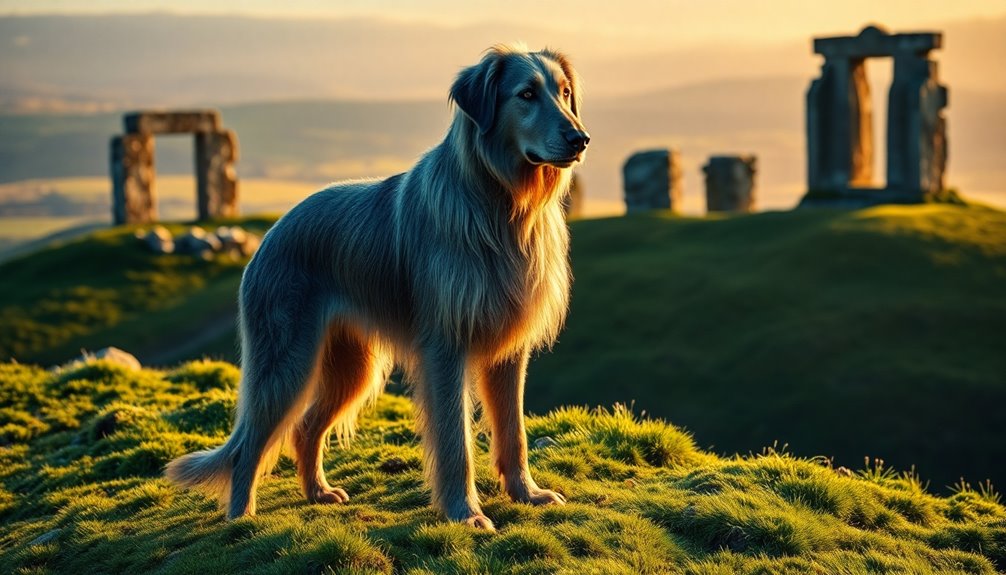
The Irish Wolfhound's history stretches back over 2,000 years, originating in Ireland around 273 BC. These remarkable dogs were bred for hunting and protection, taking down large prey like deer and boar while guarding homes from threats. As you explore their past, you'll see how their roles evolved alongside the ancient Irish nobility and warriors. The breed was once restricted to the elite, reflecting their status as symbols of nobility in ancient Irish culture.
Where and when the breed originated
Rooted in ancient history, the Irish Wolfhound boasts origins that stretch back to at least 273 BC, when its ancestors were introduced to Ireland by the Celts. These early dogs were swift hounds, prized for their strength and speed, and they quickly became integral to Celtic culture.
You'll find mentions of the breed in Roman records, with the first authentic reference dating to A.D. 391. The Irish Wolfhound is believed to have originated on the island of Inishowen in County Donegal, reflecting its deep ties to Irish geography.
As you explore its history, you'll discover that the breed spread across Europe and Asia, often gifted to royalty. They accompanied Irish Chieftains during significant events, such as the "Flight of the Earls" to France. Additionally, the Irish Wolfhound was originally utilized in battles to pull warriors from horseback and chariots, showcasing its versatility and strength.
The Irish Wolfhound shares a lineage with Scottish Deerhounds, stemming from the Irish colonization of Scotland. By the 19th century, the breed faced decline, but Captain George Augustus Graham played a crucial role in its revival. His efforts, alongside the establishment of the Irish Wolfhound Club in 1885, helped restore this noble breed to its rightful place in history.
Wolf Hunting and Protection
As the Irish Wolfhound's reputation grew throughout history, it became known not just as a noble companion but also as a formidable hunter. These dogs were essential in ancient Ireland, used to hunt wolves, elk, boar, and deer. Their strength, speed, and hunting prowess made them invaluable, often employed in packs to chase and take down large game.
With their ability to cover vast distances quickly, they played a crucial role in controlling wolf populations. Hunting with Irish Wolfhounds emphasizes the joy derived from observing their natural hunting behaviors, showcasing their unique instincts and capabilities.
Beyond hunting, Irish Wolfhounds served as protectors, guarding homes and livestock from predators and invaders. Their loyalty and protective instincts were revered, making them trusted guardians. In battle, they pulled men from horseback and chariots, symbolizing courage and loyalty in Irish mythology. Nobility prized them for these protective capabilities, often gifting them to royalty and foreign dignitaries.
However, by the 19th century, the breed faced decline due to dwindling wolf populations and excessive exportation. Efforts to revive the Irish Wolfhound began, leading to the establishment of the breed we recognize today.
This rich history highlights their dual role as both hunters and protectors, embodying the spirit of ancient Ireland.
Physical Characteristics
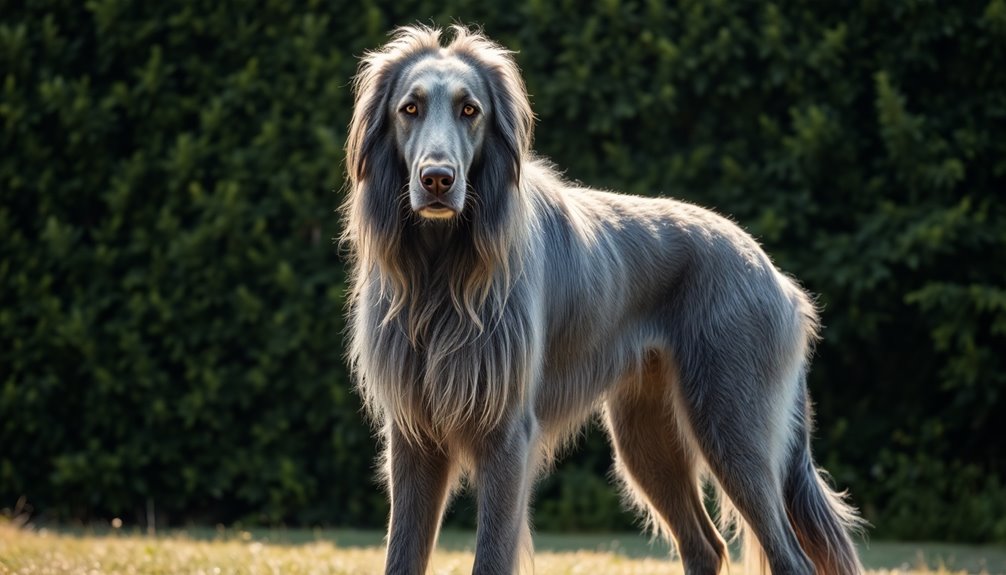
When you think of the Irish Wolfhound, you can't help but notice their impressive size and weight. Males typically stand between 30 to 32 inches tall and can weigh as much as 180 pounds, while females are slightly smaller yet still robust.
Their medium-length, wiry coat adds to their majestic appearance, showcasing a variety of colors that enhance their gentle giant persona. One of the most common coat colors is grey, which contributes to their striking look.
Size, weight, and coat details
The Irish Wolfhound, often referred to as a "gentle giant," boasts impressive physical characteristics that make it one of the tallest dog breeds. Males typically stand between 32 to 35 inches at the shoulder, while females are slightly shorter, ranging from 30 to 34 inches. By six months, males can reach about 29.6 inches, and females around 28 inches, with full height achieved by two years.
When it comes to weight, adult males usually weigh between 140 to 180 pounds, averaging around 162 pounds. Females weigh between 115 to 140 pounds, averaging about 132 pounds. They experience rapid growth in their first six months, often requiring a significant amount of food, and this growth pattern reflects their genetic potential.
The Irish Wolfhound's coat is medium-length and wiry, providing protection against harsh weather. You'll find their fur in various colors, including gray, brindle, red, black, and white.
Their coat has a medium shedding level, so grooming needs are moderate. With a sleek, athletic body structure reminiscent of the Greyhound, these dogs are built for speed while maintaining a calm and friendly demeanor.
Long, Flowing Fur Texture
Building on the impressive physical traits of the Irish Wolfhound, its coat texture plays a significant role in defining its appearance. You'll notice that the coat is rough and hard, especially around the eyes and under the jaw, where wiry hair forms bushy eyebrows. This medium-length coat not only enhances the dog's majestic look but also offers protection from varying weather and rugged terrain. The breed is recognized for its impressive size, which complements its unique coat.
The preferred coat is harsh and wiry, avoiding any wooly or silky textures. Acceptable coats maintain that wiry quality, while those that are too long or lack this rugged texture fall short of breed standards.
When grooming, avoid clipping; instead, plucking the blown coat encourages new guard hairs to grow, helping maintain the correct texture. Regular brushing, about once a week, keeps the coat healthy, while occasional baths are fine, but don't overdo it.
Patience is key, as an Irish Wolfhound's coat may not reach its full bloom until it's 3-4 years old. This unique fur texture not only preserves the breed's natural appearance but also reflects its noble character, making the Irish Wolfhound truly stand out.
Temperament and Personality
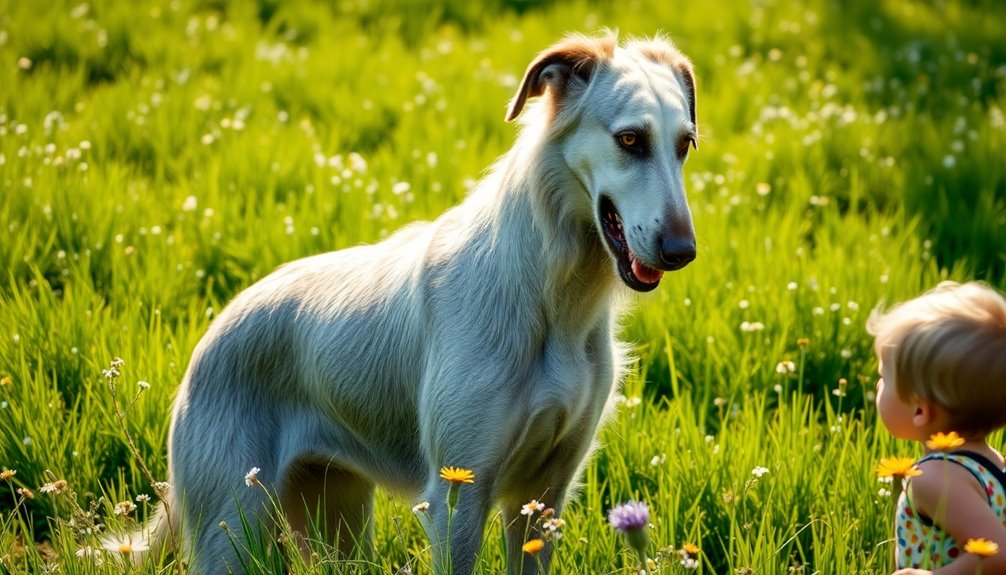
When you think of the Irish Wolfhound, you can't help but appreciate their gentle and patient demeanor. These dogs aren't just great companions for families; they also get along well with individuals and other pets. Their calm nature makes them a perfect fit for various living situations, ensuring everyone feels at ease. This gentle temperament is a hallmark of the breed, which has been historically known for its loyalty and protective nature towards families, making them a beloved family companion.
Gentle and Patient Demeanor
Irish Wolfhounds embody a gentle giant persona that captivates anyone lucky enough to encounter them. Known for their calm and friendly demeanor, these dogs rarely exhibit boisterous behavior, making them a joy to have around the house.
Their introverted nature means they often prefer quiet moments with their families, forming deep emotional bonds that are both heartwarming and fulfilling.
You'll find that Irish Wolfhounds are naturally patient, especially with children and other pets. Their loving disposition encourages affection, and they thrive in family activities. Irish Wolfhounds require ample space to stretch their long legs, making them ideal companions for families with a large yard.
With proper training and socialization, they become even gentler, showcasing their innate ability to be supportive companions.
However, it's essential to remember their emotional sensitivity; they can become destructive if left alone for too long. Maintaining companionship is crucial to their happiness.
Their keen awareness of your feelings means they're attuned to any negativity in their environment, which can affect their mood.
While they're quick learners, they respond best to firm yet gentle leadership. Using positive reinforcement is key to nurturing their intelligence and ensuring they remain the gentle souls they're meant to be.
Suitability for families, individuals, or other pets
For families seeking a loyal companion, Irish Wolfhounds make an excellent choice due to their gentle nature and protective instincts. These dogs are especially good with children, displaying patience and care, which makes them an ideal addition to households with kids. However, given their large size, you'll need to supervise interactions to prevent any accidental injuries. Irish Wolfhounds thrive on human companionship and adapt well to various living situations, whether you live in a city apartment or a country house. Their majestic presence adds to their charm, making them a striking addition to any home.
For individuals, their low-maintenance exercise needs and calm demeanor make them suitable companions. They require only short walks and light playtime, and they're intelligent and trainable, making ownership manageable. Despite their shorter lifespan, they demand the same commitment, love, and attention as any other breed.
When it comes to other pets, Irish Wolfhounds generally get along well with dogs, especially if raised together. They may chase smaller animals due to their hunting instincts, so early introductions and careful observation are crucial.
Health and Lifespan
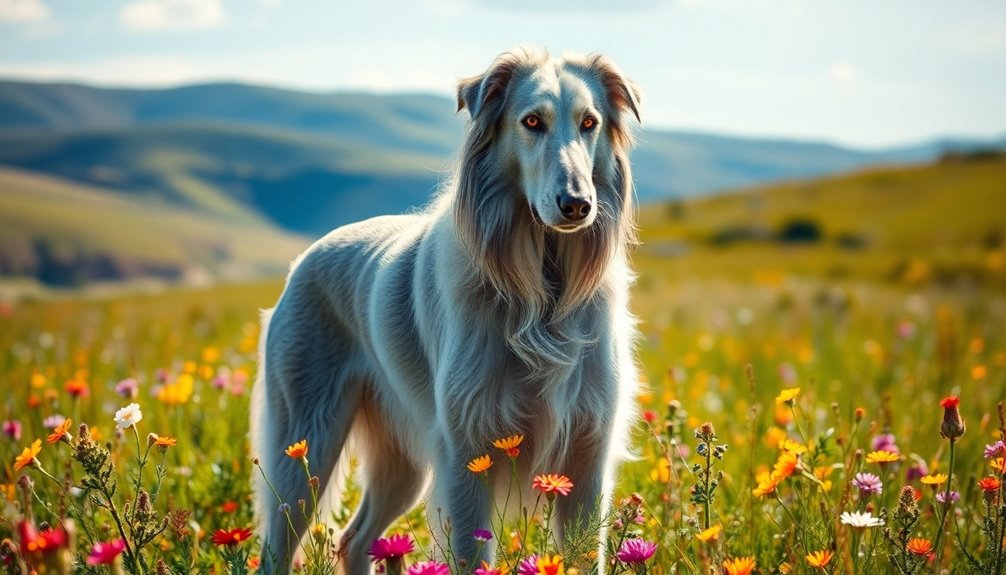
When you bring an Irish Wolfhound into your life, it's crucial to be aware of their typical lifespan, which averages between 6 to 8 years. You'll also want to keep an eye out for common health concerns like heart disease and cancer, as these can significantly impact their well-being. Regular health checks and veterinary visits are essential due to their higher risk of health issues.
Typical lifespan of the breed
How long can you expect your Irish Wolfhound to be by your side? Generally, you can anticipate a lifespan that varies between approximately 4.95 and 9.9 years, according to recent studies. The median lifespan often hovers around 6 to 6½ years, which is notably shorter than many other dog breeds.
In fact, a 2005 study revealed that 91% of Irish Wolfhounds pass away by age 10, significantly higher than the overall dog population's 35% rate.
This shorter lifespan is typical for large and giant breeds, and while some dogs may live longer than average, many factors influence longevity. Rapid growth during puppyhood can lead to health complications, while genetics play a crucial role in determining potential lifespan. Environmental conditions also contribute to your dog's health over time. Additionally, it's important to note that regular veterinary check-ups can help detect early signs of common health issues that may affect longevity.
Recent research, including a 2024 UK study, aims to clarify these lifespan estimations and correct misconceptions surrounding the breed.
As an owner, being aware of these factors can help you provide the best care for your gentle giant, ultimately maximizing the time you'll share together.
Common health concerns or genetic predispositions
Irish Wolfhounds, while known for their gentle demeanor, face several common health concerns and genetic predispositions that can impact their quality of life. One of the most serious issues is bloat or torsion (GDV), which requires immediate veterinary attention.
Bone cancer, especially osteosarcoma, is another critical concern, along with heart disease, such as dilated cardiomyopathy, which may be treatable if caught early. Their deep chests also predispose them to pneumonia.
On the genetic side, Irish Wolfhounds can inherit heart problems, hip and elbow dysplasia, and eye issues like progressive retinal atrophy. Additionally, liver shunt (PSS) is a developmental disorder that should be screened for in puppies. Regular screenings for heart problems are recommended after the age of two to catch any issues early.
Bleeding disorders, such as von Willebrand's disease, also pose risks.
As your Wolfhound ages, loss of rear end use may affect mobility, and joint issues can arise, particularly in rapidly growing puppies.
Regular health screenings, especially for the heart and hereditary conditions, are vital for maintaining their well-being. By being aware of these potential health issues, you can take proactive steps to ensure your gentle giant enjoys a happy, healthy life.
Tips for maintaining health and wellness
Maintaining the health and wellness of your Irish Wolfhound requires a proactive approach that encompasses regular veterinary care, a balanced diet, and appropriate exercise.
Schedule vet visits at least twice a year for check-ups, which should include heart screenings, orthopedic evaluations, liver function tests, and eye exams. These regular visits help you catch any developing health issues early, especially common concerns like cancer and heart disease.
A well-balanced diet is essential for their overall well-being. It should include high-quality protein, calcium, healthy fats, and complex carbohydrates to support bone and joint health while preventing obesity. Additionally, consider incorporating vet-approved recommendations for optimal nutrition tailored to their specific needs.
Consult your vet to determine the best diet plan and consider feeding smaller, more frequent meals to reduce bloat.
Don't forget about exercise! Daily walks and playtime in a fenced yard are crucial. However, avoid excessive exercise in growing puppies to prevent stress on their developing joints.
Incorporate mental stimulation through interactive toys and training sessions to prevent boredom. Regular dental care, grooming, and parasite prevention are also vital.
Care Requirements
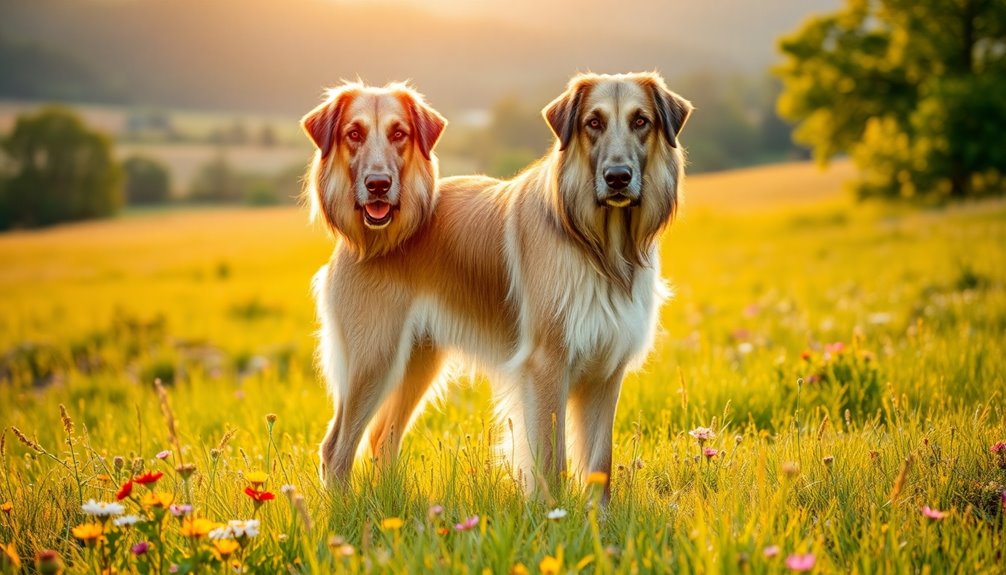
Caring for your Irish Wolfhound involves regular brushing, adequate exercise, and a balanced diet. You'll need to ensure they get 1 to 1.5 hours of daily activity, along with proper grooming to maintain their coat. Feeding them the right nutrition is crucial for their growth and overall health. Their gentle nature makes them great companions, which is essential to consider when integrating them into your family life.
Regular Brushing Required
The Irish Wolfhound's wiry coat requires regular brushing to keep it healthy and free from mats. You should brush your Wolfhound at least once a week, but more frequent sessions are beneficial, especially during shedding seasons. If your dog is particularly active, daily brushing might be necessary to remove burs and other debris.
To maintain the coat, use a pin brush or slicker brush, and consider a bristle brush to remove loose fur. Aim to comb and brush every three days, or daily for active dogs, ensuring the coat stays well-maintained. For different areas of the body, use various brush heads—a larger square head for the sides and back, and an oval head for the ears and tail. If you encounter mats or tangles, a detangling lotion can help. Regular brushing not only removes dead hair and skin but also stimulates blood flow to the skin. It allows you to spot potential health issues early, ensuring your gentle giant remains comfortable and healthy. Additionally, regular grooming sessions can enhance the bond between you and your dog, promoting trust and comfort during the process.
Don't forget other grooming practices, like trimming hair around sensitive areas and keeping nails trimmed, to maintain your Wolfhound's overall hygiene.
Exercise requirements and energy levels
Exercise is vital for the Irish Wolfhound's well-being, ensuring they stay fit and healthy. These gentle giants require about 1 to 1.5 hours of exercise each day. Aim for 2-3 walks a day, incorporating gentle jogs or free play in a securely fenced area. Swimming is also a fantastic low-impact option for them.
While regular exercise is crucial, it's equally important to balance it with adequate rest periods. Avoid excessive exercise, especially during your dog's growth stages, to prevent strain on their developing bones and joints. If you have a puppy, keep their playtime controlled until they reach 18 to 24 months, and steer clear of high-impact activities. Additionally, be aware that joint issues can arise from too much vigorous activity at a young age.
Start training early, using positive reinforcement for best results. Keep training sessions short—5 to 10 minutes—to maintain their engagement. Incorporate basic obedience commands and socialization with various people and other dogs.
Since Irish Wolfhounds can reach impressive speeds, ensure they've plenty of space to run and stretch. Monitor their weight and adjust food portions as needed.
Lastly, restrict activity right after meals to prevent bloat and other health issues.
Feeding tips and diet recommendations
Meeting the exercise needs of your Irish Wolfhound is just one part of keeping them healthy; feeding them a balanced diet plays a vital role too. Focus on high-quality, animal-based protein sources like beef, chicken, turkey, and lamb—these should be the main ingredient in their meals to support muscle growth and repair. Additionally, it's essential to evaluate risk tolerance when introducing new diet changes to ensure your Wolfhound's health is prioritized.
Incorporate raw meaty bones for dental and digestive benefits, along with offal like beef liver for essential vitamins and minerals.
Don't forget about fats! Balanced fats, including omega-3 fatty acids from salmon, are crucial for energy, skin, and heart health. You can also add safflower or cod-liver oil to their diet. Raw meat diets digest more rapidly than commercial dry food, so adopting this approach can help maintain optimal digestive health for your Wolfhound.
While your Wolfhound needs some carbohydrates, keep it limited. Include fiber-rich vegetables like butternut squash, kale, and carrots in moderation, but steer clear of nightshades and gaseous veggies like broccoli.
Lastly, ensure your dog gets enough hydration. Fresh water and moisture-rich raw foods are key.
Consider supplements like Vitamin C and Diatomaceous Earth, but always consult your vet first to tailor the diet to your gentle giant's unique needs.
Training and Socialization
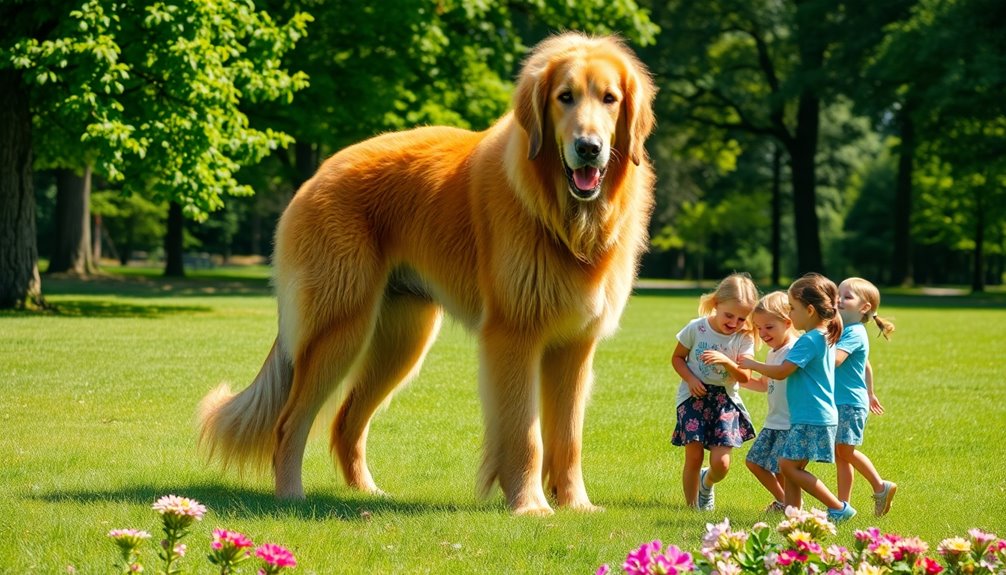
Training your Irish Wolfhound requires patience and consistency, as they're moderately responsive to commands. Gradual introductions to new environments will help them feel more comfortable and confident. To curb leash pulling during walks, start with proper leash training from an early age. Incorporating positive reinforcement during training sessions will further enhance their responsiveness and eagerness to learn.
Moderately Responsive to Commands
When it comes to training, Irish Wolfhounds are moderately responsive to commands, which means you'll need to be patient and consistent. Positive reinforcement is your best friend here. Use treats, praise, and toys to reward good behavior, as this approach works wonders with these gentle giants. Their keen sense of awareness allows them to pick up on cues during training, enhancing their ability to learn.
Keep training sessions short—around 5 to 10 minutes—to hold their attention. Start with basic commands like "sit," "stay," and "come." Remember, due to their size, they may not sit instantly on command, so give them time. Always provide immediate praise and rewards when they follow commands correctly. High-value treats can make a significant difference, so choose ones your dog loves.
Avoid punishment or harsh corrections, as they can cause your Wolfhound to shut down. Keep things fun and engaging to prevent boredom; vary your training commands and techniques.
And don't forget the importance of socialization! The earlier you introduce your puppy to different people, sounds, and environments, the better prepared they'll be for training. With patience and a gentle touch, you'll foster a strong bond and a well-behaved companion.
Gradual Introductions to New Environments
Introducing your Irish Wolfhound puppy to new environments should be a gradual process that prioritizes their comfort and security. Start by exploring familiar spaces like your home and backyard. This helps your puppy feel safe before facing new situations.
Introduce small changes, such as new toys or blankets, to ease them into minor adjustments. To create a calm atmosphere, play soothing music, which can help your puppy associate new surroundings with positive feelings. Always reward calm behavior with treats and praise, reinforcing their positive experiences. Additionally, ensure you provide proper nutrition during this phase to support their developing bodies as they adapt.
As your puppy gains confidence, gradually increase the complexity of the environments you visit. Begin with quiet areas, like a serene park, and observe their reactions. Engage them using familiar toys or games to make new settings feel less intimidating.
Keep initial visits short and rewarding, gradually extending the duration as they adapt. Introduce various surfaces, such as grass, concrete, and carpet, to help them adjust to different terrains.
Leash Pulling During Walks
Leash pulling during walks can be a common challenge for many Irish Wolfhound owners, but addressing it early can make a significant difference.
Start leash training when your pup is young and manageable in size. A well-fitted harness is essential to distribute pressure evenly across their chest and back, reducing strain on their neck. Choose a sturdy leash that can handle their strength. Incorporating high protein treats can also serve as an excellent motivator during training sessions.
Begin training in a distraction-free environment, rewarding your dog for walking calmly by your side with treats and praise. If pulling persists, consider seeking help from a professional trainer.
Use high-value treats to maintain their focus during walks and keep training sessions short, around 5-10 minutes, to match their attention span. Additionally, regular exercise is vital for an Irish Wolfhound's physical well-being, which can help channel their energy positively and reduce pulling tendencies.
Avoid using training aids without proper knowledge, as they can cause harm. Instead, focus on positive reinforcement techniques. Reward calm behavior consistently to prevent pulling and gradually introduce distractions to test their focus.
Remember, consistency in recall training, especially in off-leash scenarios, is crucial for their overall socialization and training success.
With patience and the right approach, your Irish Wolfhound can learn to walk politely on a leash.
Ideal Living Environment
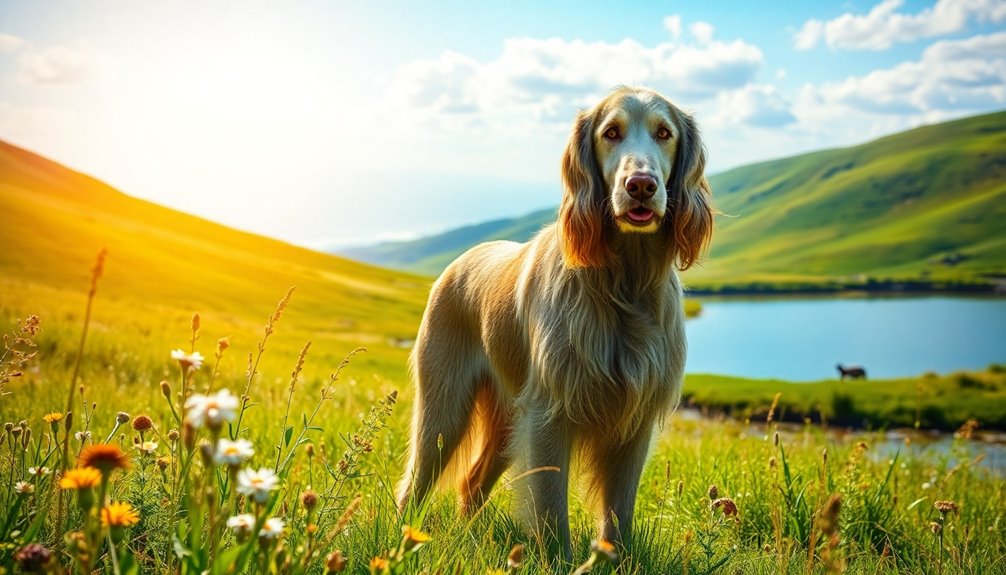
If you're considering bringing an Irish Wolfhound into your home, you'll want to ensure you have plenty of space for them to stretch out and move freely.
A secure, fenced yard is essential, as these gentle giants thrive in cooler climates and appreciate the outdoors. It's important to note that the breed requires ample space to maintain their health and well-being.
With the right environment, your Wolfhound can feel safe and comfortable while enjoying their daily exercise and relaxing at home.
Spacious Home With Secure Yard
For an Irish Wolfhound, a spacious home with a secure yard is essential to its well-being. These gentle giants require plenty of room to exercise freely, with a minimum of one acre recommended for optimal health and development. Your yard should allow for galloping, stretching, and turning, ensuring your dog can move comfortably. Additionally, due to their strong prey drive, it's important to supervise their outdoor activities to prevent any potential chasing of smaller animals.
While smaller homes or apartments can work if you provide enough space, regular access to a securely fenced area is crucial.
When it comes to fencing, make sure it's at least five feet high to prevent jumping. Use strong materials like metal chain link, wood, or woven steel, and ensure the fencing is tightly secured to prevent any escapes or injuries.
Avoid invisible fences, as they often don't contain these large dogs effectively.
Safety is paramount, so a fully secured yard protects your Irish Wolfhound from other animals or people. Avoid tying or staking out your dog, as this can lead to injury.
With a secure area for unrestricted movement, you'll help your Irish Wolfhound thrive physically and mentally, ensuring a happy and healthy life together.
Prefers Cooler Climates
Many Irish Wolfhounds thrive in cooler climates, where their natural adaptations shine. You'll notice they prefer cold weather over warm, often seeking out chilly, hard floors during the summer months. This behavior stems from their double coat, which includes a soft undercoat for insulation and a wiry top coat that protects them from harsh conditions.
They're not well-suited for hot climates, and high temperatures can stress them out, leading to lethargy. In fact, their size and coat make them more comfortable in cooler environments than in heat.
In cooler weather, your Irish Wolfhound will likely be more active, enjoying exercise and outdoor play. Their calm demeanor tends to flourish in these environments. Conversely, in warm weather, they may become less active, opting to find cooler spaces to rest.
It's essential to keep in mind that hot conditions can exacerbate health issues, such as bloat and heat stress, while cooler climates help maintain their overall health and comfort.
Ancient Breed of Royalty
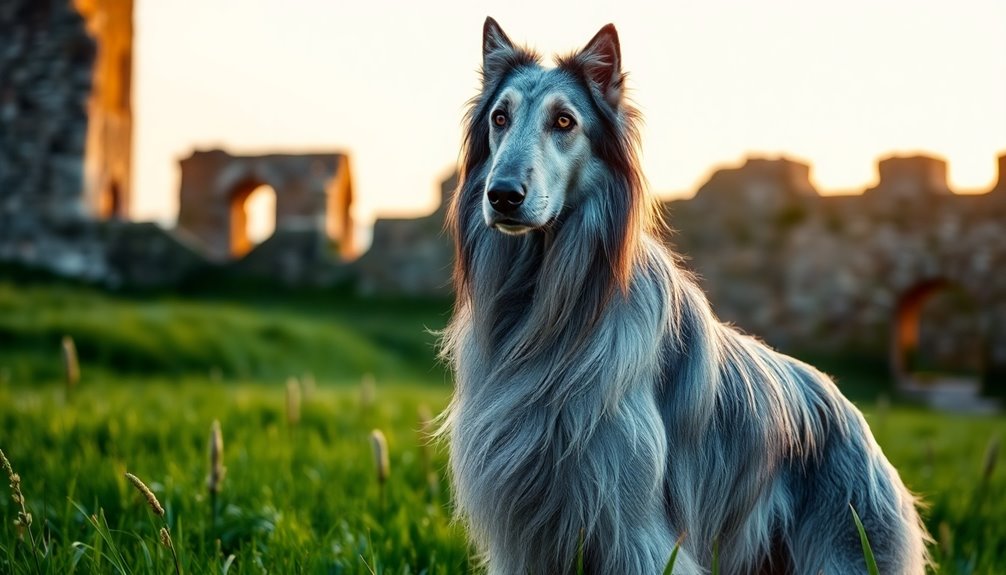
You'll find that the Irish Wolfhound's royal history isn't just about companionship; they were once used in warfare, showcasing their strength and loyalty.
Their majestic presence even earned them a spot in popular culture, like in 'Game of Thrones', where they symbolize nobility and courage. This breed's legacy intertwines with the elite, making them a true symbol of ancient royalty. Historically, they were bred by monks for hunting wolves in Ireland, known as the Hound of Ulster.
Once Used in Warfare
Throughout history, the Irish Wolfhound has stood out as a formidable presence in warfare, revered not just for its size but for its exceptional combat abilities. Dating back to the 5th century, these dogs were documented in ancient Irish literature and laws, showcasing their importance in battle.
Used by ancient Celtic warriors, they excelled in pulling men off horseback and yanking soldiers from chariots, proving their prowess in combat. The demand for Irish Wolfhounds was so high that wars were fought over their possession.
Only kings and nobility could own them, with the number permitted dictated by rank, according to Brehon Law. These dogs weren't just war companions; they also served as guardians for property and herds, emphasizing their role beyond the battlefield.
Their impressive size and strength made them superior to other breeds, and they were known to hunt big game like deer and wolves. This combination of hunting capability and combat skills solidified their status as symbols of nobility, often gifted to royalty and world leaders. Hounds were utilized specifically for hunting and guarding, reflecting their versatility and importance in Irish society.
The Irish Wolfhound's legacy as a warrior and protector endures, illustrating its unique place in history.
Featured in 'Game of Thrones
While the Irish Wolfhound didn't make a direct appearance in 'Game of Thrones,' its royal lineage and legendary status resonate throughout the series. The show's direwolves, such as Summer and Grey Wind, were portrayed using Northern Inuit dogs, which resemble wolves due to their appearance. These dogs were chosen for their intelligence and wolf-like characteristics, but the absence of Irish Wolfhounds in the series doesn't diminish their historical significance.
Dating back over 2,000 years, Irish Wolfhounds were bred by the Celts for their strength and hunting prowess. Highly prized, they were often gifted to royalty and dignitaries, symbolizing loyalty and bravery in Irish mythology. Their impressive size—standing around 36 inches tall—coupled with a calm temperament, makes them gentle giants. One of the oldest breeds, Irish Wolfhounds have a rich history that connects them deeply to Ireland's national identity.
Today, Irish Wolfhounds are celebrated as national symbols of Ireland and are cherished companions. They serve as mascots for the Irish Guards and rugby teams, appearing in cultural events like St. Patrick's Day parades.
Even without a direct presence in the series, the essence of the Irish Wolfhound embodies the noble spirit and strength that permeates the world of 'Game of Thrones.'
Gentle Giant for Spacious Homes?
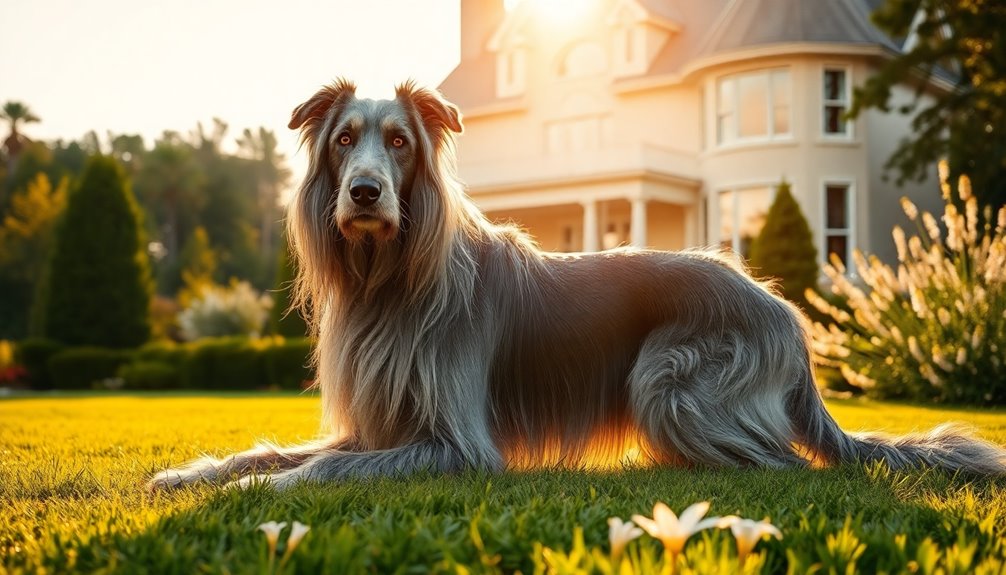
If you've got a spacious home and an active family, an Irish Wolfhound might be the perfect fit for you.
Their gentle nature makes them great companions, but you'll need to consider their grooming needs due to their long fur. Additionally, be prepared for higher veterinary expenses as their size and health considerations can lead to increased care costs.
With sufficient space and attention, these gentle giants can thrive in your household.
Ideal for Large, Active Families
The Irish Wolfhound is an ideal companion for large, active families looking for a gentle giant to join their home. With their patient and loving nature, these dogs thrive in environments filled with children. They're tolerant of energetic play and can handle the occasional bump without causing harm, making them great family pets.
Irish Wolfhounds require moderate to significant exercise, ideally around 1 to 1.5 hours a day. This includes walks, gentle jogs, and free play in a securely fenced area. For optimal health, you might want to spread their exercise throughout the day. Additionally, their gentle temperament makes them suitable companions for children, promoting a safe and nurturing atmosphere in the home. Dogs in general can provide emotional support that helps children cope with changes in family dynamics.
Just remember, if you're raising a puppy, keep their activity controlled until they reach 18 to 24 months.
In terms of living space, they adapt well to various environments but need room to stretch out and play. While they don't require vast areas, having enough space inside and outside is essential.
These loyal companions prefer being close to you and your family, thriving on human connection. If you're ready to welcome a loving and gentle giant into your home, the Irish Wolfhound could be your perfect match!
Grooming Needs for Long Fur
When it comes to grooming your Irish Wolfhound, consistency is key to maintaining their long, wiry coat. Brush your dog's coat at least once a week to remove loose fur and debris. Use a variety of tools like a rubber curry, shedding blade, and slicker brush to effectively manage their unique texture.
Avoid clipping the coat, as this alters its natural texture and color; instead, pluck the blown coat to encourage new growth. Regular grooming helps promote skin health by distributing natural oils throughout their coat.
Bathe your Wolfhound every month or two, depending on how dirty they get. Before bathing, use a high-velocity dryer to remove dirt and loose hairs, but be cautious not to bathe too frequently, as this can strip their coat of essential oils.
Keep their hygiene in check by trimming hair around sensitive areas every 4 to 6 weeks and cleaning their ears weekly.
Don't forget about nail care! Trim or grind their nails every four to six weeks to maintain healthy foot structure.
Regular grooming not only keeps your Irish Wolfhound looking great but also helps you spot any potential health issues early on.
Frequently Asked Questions
How Much Do Irish Wolfhounds Typically Weigh?
Irish Wolfhounds typically weigh between 115 and 180 pounds, depending on their gender and genetics.
Males usually average around 162 pounds, while females hover around 132 pounds.
By the time they're fully grown, which takes about 3 to 3.5 years, they'll have filled out in muscle and fat.
If you're considering adopting one, keep in mind their size and the space they'll need in your home.
Do Irish Wolfhounds Get Along With Other Pets?
Irish Wolfhounds can get along with other pets, but it requires careful introductions.
You'll want to supervise these encounters, especially with smaller animals, due to their strong hunting instincts.
Socialization is key to fostering peaceful relationships.
While they're generally calm and gentle, individual personalities vary, so patience and consistent training are essential.
With time, they can become part of a harmonious household with other pets, creating a loving environment for everyone.
What Is the Lifespan of an Irish Wolfhound?
The lifespan of an Irish Wolfhound typically ranges from 6 to 8 years, though some studies suggest a recent increase to around 9.9 years.
Factors like their large size, breeding practices, and health issues can influence their longevity.
You should be aware of common health problems, such as cancer and heart disease, that can affect them.
Regular veterinary check-ups and health screenings are crucial for maximizing your dog's lifespan and well-being.
Are Irish Wolfhounds Prone to Any Specific Health Issues?
Yes, Irish Wolfhounds are prone to several specific health issues.
You should be aware of conditions like osteosarcoma, heart disease, and bloat, which can be life-threatening. Joint and bone disorders, such as hip dysplasia and panosteitis, may affect them too.
Additionally, they can experience eye disorders and low thyroid levels. Regular veterinary check-ups and screenings can help catch these issues early, so staying proactive about their health is essential.
How Much Exercise Do Irish Wolfhounds Need Daily?
Irish Wolfhounds need 1-2 hours of exercise daily when they're adults. You can split this time into shorter sessions throughout the day.
For puppies, it's important to limit their exercise to protect their developing bones and joints. Once they're fully grown, you can introduce gentle jogs and off-lead play in safe areas.
Always remember to include mental stimulation and training to keep them happy and healthy. Consult your vet for personalized guidance.
Conclusion
In conclusion, the Irish Wolfhound is truly a gentle giant that brings warmth and companionship to any home. With their rich history and regal demeanor, these dogs thrive in spacious environments where they can roam freely. Their affectionate nature and unique personality make them wonderful family members. By providing proper training and socialization, you'll ensure your Wolfhound becomes a well-mannered and loving companion. Embrace the joy of sharing your life with this magnificent breed!


